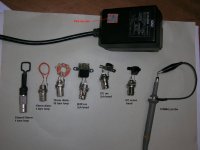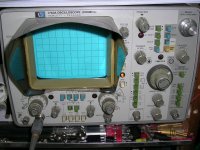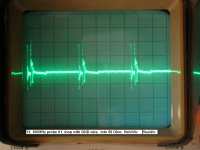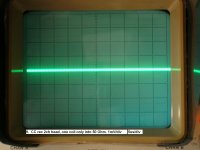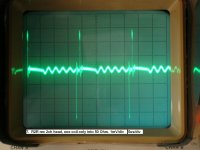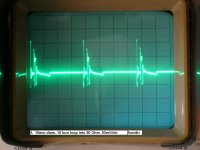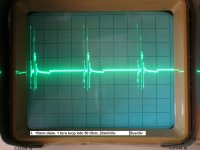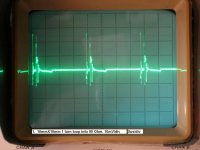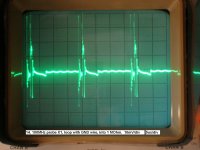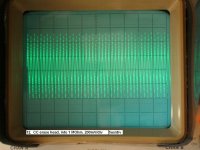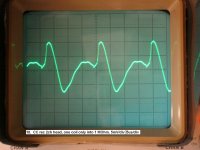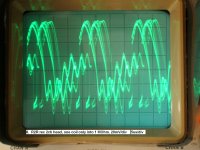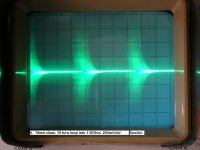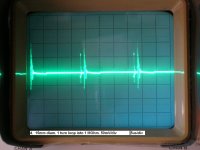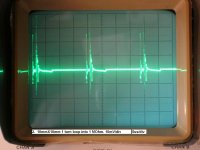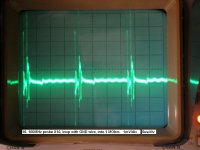I noticed a new (paid) version of the DR meter is available. MAAT DROffline Sadly they don't give details of the algorithm and it's still of limited use on classical music, but at least gives you an inkling of the crest factor that the music you listen to actually has.
I noticed a new (paid) version of the DR meter is available. MAAT DROffline Sadly they don't give details of the algorithm and it's still of limited use on classical music, but at least gives you an inkling of the crest factor that the music you listen to actually has.
Hmmmm also interesting BUT how will this help us have more accurate audio?
I know this Forum has never been very focused. But..... what is this good for? … knowing crest factor of my music? For $15.
THx-RNMarsh
Last edited:
It allows you to see how compressed your music is. I would argue that music with a low crest factor is over processed and therefore not suitable for the 'ears only' brigade to use to claim their ability to hear things. However it allows us one dimension of filtering to give a figure of merit on a vital aspect of accuracy in the source.
YMMV and you may feel you can tell ppm differences with stuff compressed into the top 6dB.
YMMV and you may feel you can tell ppm differences with stuff compressed into the top 6dB.
If one is considering paying for this kind of software, there is an alternative that offers in-depth analysis of music recordings:
https://www.xivero.com/musicscope/#
Price-wise it is in the neighbourhood of the full Maat DRMeter version, but it analyzes in accordance with the current EBU/ITU algorithms. It does not output the DR value, though.
I've been using this software since the first release, and it paid for itself by providing me in two cases with the proof that the HD music I downloaded was in fact not HD, so I was able to get my money back.
As a disclaimer, I'm in no way whatsoever associated either of the S/W products mentioned above.
Regards,
Braca
https://www.xivero.com/musicscope/#
Price-wise it is in the neighbourhood of the full Maat DRMeter version, but it analyzes in accordance with the current EBU/ITU algorithms. It does not output the DR value, though.
I've been using this software since the first release, and it paid for itself by providing me in two cases with the proof that the HD music I downloaded was in fact not HD, so I was able to get my money back.
As a disclaimer, I'm in no way whatsoever associated either of the S/W products mentioned above.
Regards,
Braca
I noticed a new (paid) version of the DR meter is available. MAAT DROffline Sadly they don't give details of the algorithm and it's still of limited use on classical music, but at least gives you an inkling of the crest factor that the music you listen to actually has.
I may have already posted this, but the free Orban meter is highly informative and once calibrated really useful for mastering as well as seeing DR via the PPM and potential intra-sample peaks and overs via the Reconstructed Peak meter. Download:
METER — Orban
Howie
Thanks Howie, I'll download that and have a play. will be interesting to see what the differences are. Certainly in the marketing blurb for DROffline they make a big play about it NOT being BS.1770 compliant.
Can you comment as one of the few here who has experience of what raw music is like before it gets any compression done as to how much gets lost when squishing things down to a broadcastable signal? I remember being grumpy at the BBC in the days when I listened to FM as the evening concerts had the optimod set so people driving home could listen in their cars and that really did take the peaks off a symphony orchestra.
Can you comment as one of the few here who has experience of what raw music is like before it gets any compression done as to how much gets lost when squishing things down to a broadcastable signal? I remember being grumpy at the BBC in the days when I listened to FM as the evening concerts had the optimod set so people driving home could listen in their cars and that really did take the peaks off a symphony orchestra.
Thanks Howie, I'll download that and have a play. will be interesting to see what the differences are. Certainly in the marketing blurb for DROffline they make a big play about it NOT being BS.1770 compliant.
Can you comment as one of the few here who has experience of what raw music is like before it gets any compression done as to how much gets lost when squishing things down to a broadcastable signal? I remember being grumpy at the BBC in the days when I listened to FM as the evening concerts had the optimod set so people driving home could listen in their cars and that really did take the peaks off a symphony orchestra.
Hey Bill,
You certainly just summed up the mindset of most FM and many web radio program directors which is process for cars...and then some. Keep in mind that the a fully modern analog FM transmission system has up to 100dB of potential dynamic range. Whether the receive end has a strong enough signal and equipment to resolve it is another story. DAB and HDRadio are, on the other hand, compressed low-bitrate channels with (to my ears) non-linear lower dynamic range. Without getting into an exhausting and nauseating monologue of how radio program directors want to be the loudest thing on the dial, I can tell you the variables used to achieve loudness are overall AGC and multi-band unlinked compression which I despise.
Musicians and producers spend their lives and a lot of money tweaking mixes for the desired dynamic range and emotional impact. IMHO it is unethical to mess with that whenever possible. With the advent of CDs the available perceived (if not actual with dither) dynamic palette increased and was utilized. With the advent of HD downloads the available dynamic range is extremely wide. Unfortunately many recording producers confuse their jobs with that of a radio program director and output product already squashed to 8dB DR or less...what a bunch of jacka$$es! No one will ever hear the good mix when they do that!
Based on experience in recording studios and out of respect for musicians intent, I run the Optimod 8500 at WXYC with 10dB of AGC to help compensate for DJs (lack of) correct level setting, but zero compression. On a good system the sound is extremely good and dynamic. The same processing is done to our webstream and I have a private 320KB/s confidence stream which sounds basically like the source in the studio.
If one is hosting a news channel I can certainly understand large amounts of compression, typically running the AGC for a 20 dB+ range with compression set for upward gain of 10-15 dB per band, with gating active on a band to band basis. End result is 3-5dB of dynamic range.
Many pop stations (rock, adult contemporary, country) run AGC at 20dB and run compression to limit dynamic range to 3-5dB. I can't even listen to them, it is both exhausting and infuriating.
Classical presets on Optimods ustilize a lot of AGC, but with a very long attack time (5-10 seconds), and usually little multi-band compression. The result can be as much as 14dB of average to peak.
Why did you have to get me started on radio processing??? Now I need a drink and it is only 9am...
Howie
Sorry 🙂, but was very informative.
Hifinews used to have a radio column which discussed this a lot. I have to say I've started listening to BBC on the webstream now, which seems a lot less compressed. Oddly the BBC TV feed is also less compressed than the FM, so watching the concert is a good option.
The flip side of this is the difficulty watching a film on bluray late at night*. Movies on TV compress the FX channels to allow good dialogue. Bluray (correctly) leaves it unmolested. I need a center channel really just for this case.
*Hopefully wont be long until they will both sleep through the explosions etc coming from the living room 🙂
Hifinews used to have a radio column which discussed this a lot. I have to say I've started listening to BBC on the webstream now, which seems a lot less compressed. Oddly the BBC TV feed is also less compressed than the FM, so watching the concert is a good option.
The flip side of this is the difficulty watching a film on bluray late at night*. Movies on TV compress the FX channels to allow good dialogue. Bluray (correctly) leaves it unmolested. I need a center channel really just for this case.
*Hopefully wont be long until they will both sleep through the explosions etc coming from the living room 🙂
It allows you to see how compressed your music is.
.
Cant you tell by Listening that it is very compressed? I can.... so why buy a meter to tell me what I hear as compressed , IS compressed by X dB's ??
It is possible to have HD digital recordings with no or minimal compression from sites. I only use those. No LP and no more CD's bought. You know... that greater accuracy thing.
THx-RNMarsh
Last edited:
I use a tiny inductive pick up. calibrated. But relative numbers are OK for this purpose.... make your own.
Some home made pickups, probing at a particular point at the enclosure of a wall wart SMPS .
100MHz analog scope. Time base is 5us/div
George
Attachments
Cant you tell by Listening that it is very compressed? I can.... so why buy a meter to tell me what I hear as compressed , IS compressed by X dB's ??
It is possible to have HD digital recordings with no or minimal compression from sites. I only use those. No LP and no more CD's bought.
THx-RNMarsh
Can you suggest an HD recording that has minimal compression from ears only listening? The most dynamic recordings I have were ones I might have missed without having a database of DR references. Well that And Bob Cordell having found the Rickie lee Jones track that I use to check headroom CordellAudio.com - Home Entertainment Show 2007
How can we make a LVDT an integral part of the loudspeaker Voice coil assembly - with suitable modifications?
THx-RNMarsh
THx-RNMarsh
These are with the pickups on 1 MOhm input.
George
All good. I used similar pickup as you have used with record heads. Video record head from old VCR. The noise data I put up from various products used that Video head into spec analyzer. The very small head gap allows pin point measurement. I just placed it next to the DUT's ac power cord and turn on the DUT and that is what I showed coming from most everything in your home and music system.
My data looks funny because it was from a Polaroid film pack TEK C4 camera to TEK scope screen... some parallax seen. About 10+ years ago? Anyway.... thx for showing us your pick-up probes. Note the loop diameter limit/determines the BW of the probe.
Nice 🙂 😎
THx-RNMarsh
Last edited:
Can you suggest an HD recording that has minimal compression from ears only listening? The most dynamic recordings I have were ones I might have missed without having a database of DR references. Well that And Bob Cordell having found the Rickie lee Jones track that I use to check headroom CordellAudio.com - Home Entertainment Show 2007
Too many to list --- anything from Dave Wilson Audio (RIP)... anything from Kavi Alexander.... anything from Harmonia Mundi... etc. Direct mic preamp to recorder.
THx-RNMarsh
You SURE about that
Album list - Dynamic Range Database
Yes. start with Kavi's recordings [Water Lily Records/Acoustics] --- I will stake my life on it. I will hang my self in the morning if I am wrong. No added compression. No EQ. No limiting.... nothing but a pair of micrphones. How do I know... he says so... but actually I produced one of his recording and was at the recording site (church). Saw it with my own peepers. Didn't produce for D.Wilson but was at a recording and know his setup and he doesn't do anything to the sound either. Was at recording for H.Mundi at Lucas Films ranch. etal.
Doubt if a meter can always tell if a dynamic range is normal or artificially compressed. Some music just isn't very dynamic in loudness..... doesn't mean it was compressed though.
THx-RNMarsh
Last edited:
My water Lily are all vinyl. I'll go hunting for something downloadable that I might actually want to listen to more than once. Just to ensure I am being fair here, there should be no difference in DR between the redbook and HD versions of this as it is stated that no processing occurs downstream of the tape recorder? I'd rather buy two redbook titles to get a spread rather than one HD as we are only looking at DR/crest factor in this.
"I'd assume are quite audible" - why?. From what I can gather RNMarsh is suggesting that the stock answer to such plots is that the fundamental signal will mask the audibility of the close-in frequency sidebands >-70dB below the main signalThat's cute, because it does more to say that well behaving stuff is inaudible to miklos versus a pretty ugly looking pair of plots I'd assume are quite audible. (Post 6312) Methinks it's worth your while to reread Julian Dunn's work on jitter and the j test.
nah. Not that involved or interested.... unless it leads to something I can do that improves my designs/system. Just poking fun at the nay Sayers who wont listen for themselves yet who say you cant hear this or that.
Some day... if I live long enough.... I'll get out my jitter measuring instrument and try it.
A test I would be interested in is one which shows any dynamic affect on imaging, as a few suggested. And what specifically will improve it.
Thx-RNMarsh
I too would be interested in how music signal would have been differentiated (& with what characteristics) with the same jitter applied.Maybe Miklos has tried this although his test is from last year?
- Status
- Not open for further replies.
- Home
- Member Areas
- The Lounge
- John Curl's Blowtorch preamplifier part III
